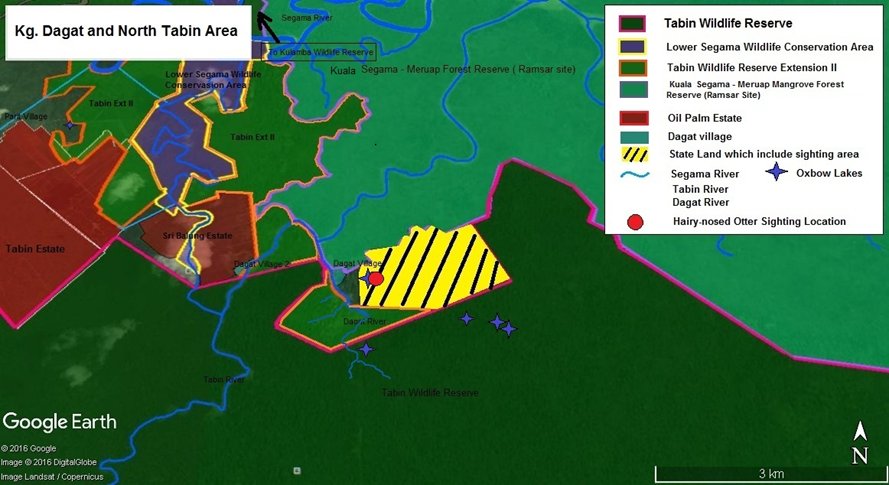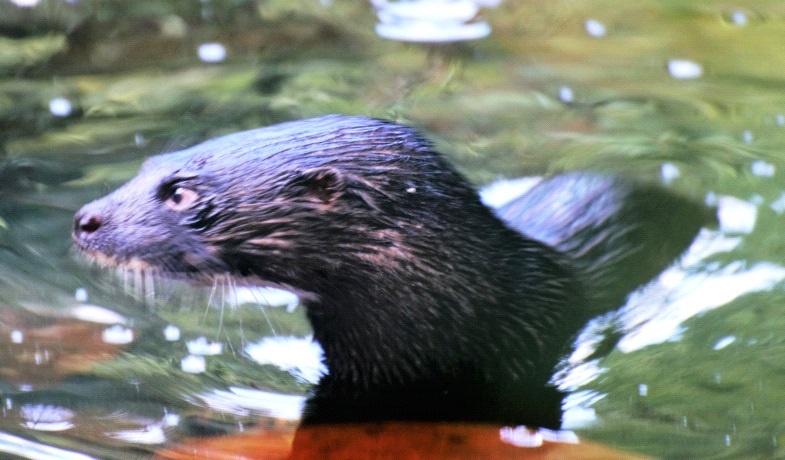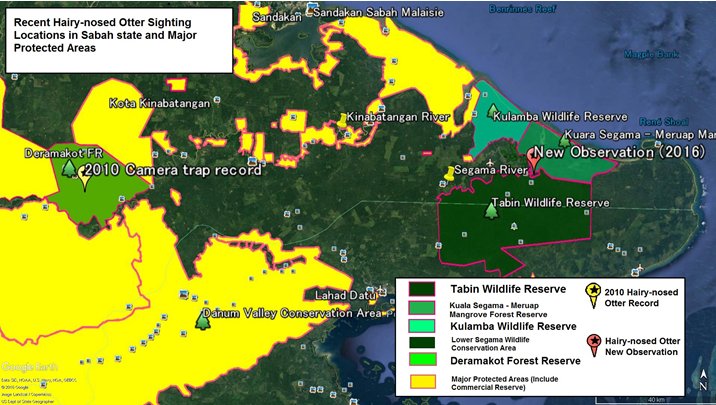IUCN/SSC Otter Specialist Group Bulletin

©IUCN/SCC Otter Specialist Group
Volume 34 Issue 2 (October 2017)
Citation: Ishigami, J, Ambu, LN, Tuuga, A and Tsubouchi, T (2017). The Second Recent Record of Hairy-Nosed Otter (Lutra sumatrana) in Sabah, Malaysia. IUCN Otter Spec. Group Bull. 34 (2): 67 - 72
The Second Recent Record of Hairy-Nosed Otter (Lutra sumatrana) in Sabah, Malaysia
Junichi Ishigami1, Laurentius Nayan Ambu1, Augustine Tuuga2 and Toshinori Tsubouchi1,3
1Borneo Conservation Trust
2 Sabah Wildlife Department
3 3Seisa University Graduate School of Education
E-mail: jun1tunosi@gmail.com
ambu56@gmail.com,
Augustine.Tuuga@sabah.gov.my,
t_tsubouchi@seisa.ac.jp,



 |
| (Received 20th December 2016, accepted 27th March 2017) |
| Download PDF (861 KB) |
| Abstract: A Hairy-nosed Otter (Lutra sumatrana) was sighted and photographed in an area near the village of Dagat, Lower Segama, Sabah, Malaysia, on 16th April 2016. Available literature on L. sumatrana suggested that this is the second recent record in the state of Sabah, Malaysia. There are 12 confirmed specimen records collected from the island of Borneo. In the Sabah state, there are two specimen records which are from Mengalong River in 1876 and from Sandakan in 1880. All of recent specimen records from the island of Borneo are collected from Brunei Darussalam. In the Sabah state, the first recent record was in Deramakot Forest Reserve in 2010, camera trapped by the carnivores study spearheaded by the Sabah Wildlife Department. The Deramakot Forest Reserve is about 130km away from the present locality record. Due to the paucity of data on the species’ population status and its conservation status, it is highly suggested and timely that a state-wide survey of this species be undertaken in order to understand its population status, density and distribution in Sabah. |
| Keywords: Hairy-nosed Otter, Lutra sumatrana, Dagat, Tabin, Ramsar |
| Française | Español |
INTRODUCTION
The Hairy-nosed Otter (Lutra sumatrana) is distributed at scattered locations in Southeast Asia. Records of both collecting and sighting for this species are fewer than for the other two otter species on the island of Borneo (Fig 1). There are 12 confirmed specimen records collected from the island of Borneo: two from Sabah, four from Sarawak, four from Brunei, and two from Kalimantan. All recent specimen records from the island of Borneo are collected from Brunei Darussalam. The latest specimen recorded was a road killed specimen collected at Brunei Darussalam in 1990 (Sasaki et al., 2009).
In the state of Sabah, the status of this species was unknown since there was no recent formally record until one animal was photographed by camera trap at Deramakot Forest Reserve in 2010.
SIGHTING LOCATION
The location of the sighting is a small oxbow lake on state land some 500m east of the village of Dagat, 650m north of Tabin Wildlife Reserve and 600m south of the Ramsar Site. GPS coordinates of the location are 5° 21'52"N 118° 46'45"E. The altitude of the area around sighting location is 20 – 30m a.s.l. (Figure 1, 2).
The 550 acres of state land is a mixture of secondary freshwater swamp forest and lowland dipterocarp forest, containing some oxbow lakes. The nearest river to the sighting location is the Dagat River which is 600m away. Dagat River and Mantis River connect to Tabin River which ultimately flows into the lower part of the Segama River.
The sighting location is in the Tabin Wildlife Reserve (1,225km2) and the Kuala Segama - Meruap Mangrove Forest Reserve (176.5km2). The Tabin Wildlife Reserve is the largest wildlife reserve in the state of Sabah, with class VII classified forest. It is mainly covered by lowland dipterocarp forest except the low altitude northern part where it is covered by swamp forests. There is some Primary Forest in the central area which called Core Area.

|
| Figure 3. Location of the sighting site in the Tabin Wildlife Reserve and the LKSW Ramsar site, where the freshwater swamp forest and the lowland dipterocarp forest mix. (click for larger version) |
The Kuala Segama - Meruap Mangrove Forest Reserve contains large scale Nippah swamp forest and Class V Mangrove forest. This Mangrove forest reserve is a part of the Lower Kinabatangan - Segama Wetland Ramsar site (788.03km2) which is the largest Ramsar site in Malaysia.
There are two connections between the Tabin Wildlife Reserve and the Kulamba Wildlife Reserve which is the second largest wildlife reserve (206km2) in the state of Sabah, and also a part of the Ramsar site. The connectivity through Kuala Segama – Meruap Mangrove Forest Reserve is wider but almost covered by swamp forest such as Nippah swamp forest and Mangrove forest. Connectivity through the Lower Segama Wildlife Conservation Area (24km2) along the Tabin River is the only connectivity through dry land. However, the forest is thin and degraded, and also there is abundant human disturbance.
Because of the importance of dry land connectivity between these two largest wildlife reserves, the land beside the Lower Segama Wildlife Conservation Area has been gazetted recently as the Tabin Wildlife Reserve Extension II, the Kulamba wildlife Reserve Extension II, and the Sungai Segama Forest Reserve.
SIGHTING DETAIL
The observation was recorded on the 16th April 2016. The sighting time was between 0936 to 0948 hours as follows:-
0920 hours - The observer was resting at the edge of a small oxbow lake
0936 hours - A lone otter was observed swimming, diving and surfacing in the lake repeatedly
0938 hours - The otter detected the presence of the observer. It swam towards the observer and stopped about 4m away and began to perform threat behavior, uttering short "grrrp" sounds for several minutes before it swam back to the middle of the oxbow lake. The otter then repeated this sequence, going back to the observer and making threat sounds. The otter repeated this behavior several times. A short video recording was taken; (Figure 4-6)
0948 hours – The otter climbed to the bank of the other side of the oxbow lake.
 |
| Figure 4. L. sumatrana at Dagat Village. The rhinarium covered by short hair (click for larger version) |
 . . |
| Figure 5. Side view of the L. sumatrana‘s head at Dagat Village showing flat skull. (click for larger version) |
 |
| Figure 6. L. sumatrana at Dagat Village when it was scanning upward. It is showing white patch on upper lip to under chin clearly. (click for larger version) |
CONDITIONS
The weather was cloudy. The water level was clear and somewhat at low tide. Some fish, probably Snakehead (Channa striata) and Climbing Perch (Anabas testudineus) were observed in the lake and those fishes could have attracted the otter. Birds such as Oriental Paradise Flycatcher (Terpsiphone affinis) and White-crowned Forktail (Enicurus leschenaulti) were observed at the edge of the oxbow lake while some Black-and-red Broadbills (Cymbirhynchus macrorhynchos) were nesting on some branches above water.
Due to the lack of, or decrease in, rainfall and prolonged period of drought as an effect of El Niño since 2015, the smaller oxbow lakes, pond and forest rivulets dried up. The water level of the oxbow lake and Dagat River has been drastically reduced several feet by the prolonged drought.
DISCUSSION
The solitary otter observed in this site is presumably part of a population different from that camera-trapped in Deramakot Forest Reserve in 2010. The two areas are about 130km away from each other, cut off by settlements, road and other land use. During the sighting, the otter was solitary. It cannot meaningfully be speculated whether the lone otter is a resident of the area or a visitor.
It is possible that after activities of logging and clearance have decreased in the lower Segama River, populations of wildlife come back to this area. This phenomenon augurs well for gazetting of the Lower Segama Conservation Area. The area between the Lower Segama Conservation Area, the Kuala Segama – Meruap Mangrove Forest Reserve and Tabin Wildlife Reserve need further investigation as to the composition of wildlife, include river line species.
CONSIDERATION FOR CONSERVATION
The ecosystem between North of Tabin Wildlife Reserve, south of the Lower Segama Conservation Area and the Kuala Segama - Meruap Mangrove Forest Reserve needs to be investigated extensively.
L. sumatrana was reported several times by the fauna surveys conducted by Sabah Wildlife Department though no verification was possible so these cannot be treated as authenticated records. Sabah Wildlife Department believes that this species would occur in the wide range of the state of Sabah.
In view of the endangered conservation status of this particular species, a species management plan is indispensable. Thus, statewide survey on the distribution and the status of the species is a prerequisite for the development of the species management plan as soon as possible.
Acknowledgements: Thanks to Mr. Suhailie Kahar, Mr. Gary Albert and Dr. Prof. Hiroshi Sasaki for helping identify the Hairy-nosed Otter. Thanks to Mr. Yamrin Ramsa and Mr. Hasfian Hassan for bringing me to the sighting site for the first time. Thanks to Mr. Najib Ramsa for helping me to explain to villagers about this sighting report during a village meeting. Thanks to Dagat village people for allowing me to publish this sighting record. Thanks to Dr. Arno Gutleb for proofreading this report and supporting me during finalization of this sighting report. Thanks to Dr. Will Duckworth for reviewing and giving me helpful advice. Thanks to Mr. Toshio Shatani for the corrected Spanish Abstract.
REFERENCES
Sasaki, H., Burhanuddin, M.N., Budsabong, K. (2009). Past and present distribution of the Hairy-nosed Otter Lutra sumatrana Gray 1865. Mammal Study 34: 223-229.
IUCN. (2015). The IUCN Red List of Threatened Species. Version 2015.2.
Payne, J., Francis, C.M. (2007). A field guide to the mammals of Borneo. The Sabah Society, Kota Kinabalu.
Wilting, A., Samejima, H., Mohamed, A. (2010). Diversity of Bornean viverrids and other small carnivores in Deramakot Forest Reserve, Sabah, Malaysia. Small Carnivore Conservation, 42: 10-13.
Résumé : Le Second Enregistrement Recent de la Loutre de Sumatra (Lutra sumatrana) au Sabah, Malaisie
La loutre de sumatra (Lutra sumatrana) a été aperçue et photographiée le 16 Avril 2016 dans une zone proche du village de Dagat dans le bat Segama, Sabah, Malaisie. La littérature disponible sur L. sumatrana suggère que cela correspond au second enregistrement dans l'état de Sabah. Il y a 12 enregistrements confirmés de ce spécimen de loutre collectés de l'île de Borneo. Dans l'état de Sabah, il y a deux enregistrements de ce spécimen qui proviennent l'un de 1976 de la rivière Mengalong et le second de 1880 de Sandakan. Tous les enregistrements récents de l'île de Borneo sont collectés en provenance de Darussalam. Dans l'état de Sabah, le premier enregistrement récent fut dans la réserve forestière de Deramakot en 2010, photographié par l'étude des carnivores menée par le département de la faune de Sabah. La réserve forestière de Deramakot est éloignée d'environ 130 km de la localisation de l'enregistrement présent.
A cause de la pauvreté des données sur le statut de la population de cette espèce et de son statut de conservation, il est hautement suggéré qu'une enquête à l'échelle de l'état sur cette espèce doit être menée pour comprendre le statut de cette population, sa densité et sa distribution au Sabah.
Revenez au dessus
Resumen:Segundo Registro Reciente De La Nutria De Sumatra (Lutra sumatrana) En Sabah, Malasia
El 16 de abril de 2016, se realizó un avistamiento de la Nutria de Sumatra (Lutra sumatrana) en el área cercana al pueblo de Dagat Village, Lower Segama, Sabah, Malasia. La literatura disponible sobre L. sumatrana sugirió que este es el segundo registro reciente en el Estado de Sabah, Malasia. Hay 12 registros de muestra confirmados recogidos de la isla de Borneo. En el estado de Sabah, hay dos expedientes del espécimen que son del río de Mengalong en 1876 y de Sandakan en 1880. Todos los expedientes recientes del espécimen de la isla de Borneo se recogen de Brunei Darussalam. En el estado de Sabah, el primer registro reciente fue en la Reserva Forestal de Deramakot en 2010, cámara atrapada por el estudio de carnívoros encabezado por el Departamento de Vida Silvestre de Sabah. La Reserva Forestal de Deramakot está a unos 130 km de distancia de la localidad actual. Debido a la escasez de datos sobre el estado de la población de la especie y su estado de conservación, es altamente sugerido y oportuno que se lleve a cabo una encuesta a nivel estatal de esta especie para entender su estado, densidad y distribución en Sabah.
Vuelva a la tapa

